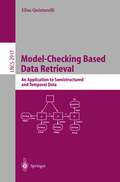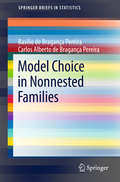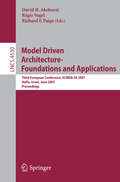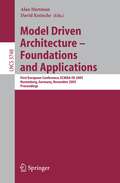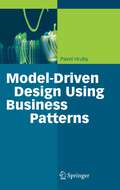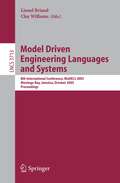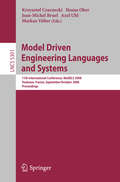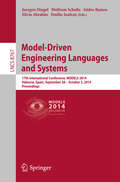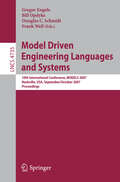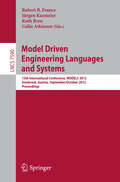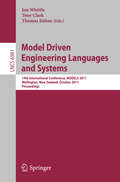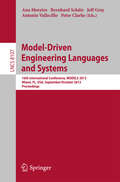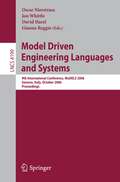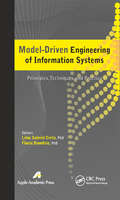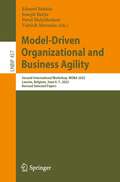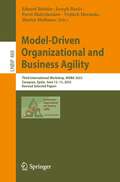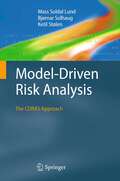- Table View
- List View
Model Building in Mathematical Programming
by H. Paul WilliamsThe 5th edition of Model Building in Mathematical Programming discusses the general principles of model building in mathematical programming and demonstrates how they can be applied by using several simplified but practical problems from widely different contexts. Suggested formulations and solutions are given together with some computational experience to give the reader a feel for the computational difficulty of solving that particular type of model. Furthermore, this book illustrates the scope and limitations of mathematical programming, and shows how it can be applied to real situations. By emphasizing the importance of the building and interpreting of models rather than the solution process, the author attempts to fill a gap left by the many works which concentrate on the algorithmic side of the subject. In this article, H.P. Williams explains his original motivation and objectives in writing the book, how it has been modified and updated over the years, what is new in this edition and why it has maintained its relevance and popularity over the years: http://www.statisticsviews.com/details/feature/4566481/Model-Building-in-Mathematical-Programming-published-in-fifth-edition.html
Model Building in Mathematical Programming
by H. Paul WilliamsThe 5th edition of Model Building in Mathematical Programming discusses the general principles of model building in mathematical programming and demonstrates how they can be applied by using several simplified but practical problems from widely different contexts. Suggested formulations and solutions are given together with some computational experience to give the reader a feel for the computational difficulty of solving that particular type of model. Furthermore, this book illustrates the scope and limitations of mathematical programming, and shows how it can be applied to real situations. By emphasizing the importance of the building and interpreting of models rather than the solution process, the author attempts to fill a gap left by the many works which concentrate on the algorithmic side of the subject. In this article, H.P. Williams explains his original motivation and objectives in writing the book, how it has been modified and updated over the years, what is new in this edition and why it has maintained its relevance and popularity over the years: http://www.statisticsviews.com/details/feature/4566481/Model-Building-in-Mathematical-Programming-published-in-fifth-edition.html
Model Business Letters, Emails and Other Business Documents
by Shirley TaylorFor anyone who wants to communicate effectively in business,this is your complete reference guide for any form of written communication. Packed with over 500 sample documents, over 100 tips for better business writing and useful templates you can apply to your writing immediately, Model Business Letters will help you put the key rules of good business writing into action.
Model Business Letters, Emails and Other Business Documents
by Shirley TaylorFor anyone who wants to communicate effectively in business,this is your complete reference guide for any form of written communication. Packed with over 500 sample documents, over 100 tips for better business writing and useful templates you can apply to your writing immediately, Model Business Letters will help you put the key rules of good business writing into action.
Model-Checking Based Data Retrieval: An Application to Semistructured and Temporal Data (Lecture Notes in Computer Science #2917)
by Elisa QuintarelliModel Choice in Nonnested Families (SpringerBriefs in Statistics)
by Basilio de Pereira Carlos Alberto PereiraThis book discusses the problem of model choice when the statistical models are separate, also called nonnested. Chapter 1 provides an introduction, motivating examples and a general overview of the problem. Chapter 2 presents the classical or frequentist approach to the problem as well as several alternative procedures and their properties. Chapter 3 explores the Bayesian approach, the limitations of the classical Bayes factors and the proposed alternative Bayes factors to overcome these limitations. It also discusses a significance Bayesian procedure. Lastly, Chapter 4 examines the pure likelihood approach. Various real-data examples and computer simulations are provided throughout the text.
Model Driven Architecture: European MDA Workshops: Foundations and Applications, MDAFA 2003 and MDAFA 2004, Twente, The Netherlands, June 26-27, 2003, and Linköping, Sweden, June 10-11, 2004, Revised Selected Papers (Lecture Notes in Computer Science #3599)
by Uwe Aßmann Mehmet Aksit Arend RensinkModel-Driven Architecture (MDA) is an initiative proposedby the Object M- agement Group (OMG) for platform-generic software development. MDA s- arates the speci?cation of system functionality from the implementation on a speci?c platform. It is aimed at making software assets more resilient to changes caused by emerging technologies. While stressing the importance of modeling, the MDA initiative covers a wide spectrum of research areas. Further e?orts are required to bring them into a coherent approach based on open standards and supported by matured tools and techniques. Thisvolumecontainstheselectedpapersoftwoworkshopson“Model-Driven Architecture – Foundations and Applications” (MDAFA): MDAFA 2003 held at the University of Twente, Twente, The Netherlands, June 26–27, 2003, and MDAFA 2004 held at Linko ¨ping University, Link¨ oping, Sweden, June 10–11, 2004. The goal of the workshops was to understand the foundations of MDA, to share experience in applying MDA techniques and tools, and to outline future research directions. The workshops organizers encouraged authors of accepted papers to re-submit their papers to a post-workshop reviewing process; 15 of these papers were accepted to appear in this volume on MDA.
Model Driven Architecture - Foundations and Applications: Third European Conference, ECMDA-FA 2007, Haifa, Israel, June 11-15, 2007, Proceedings (Lecture Notes in Computer Science #4530)
by David Akehurst Regis Vogel Richard PaigeThis book constitutes the refereed proceedings of the Third European Conference on Model Driven Architecture: Foundations and Applications, ECMDA-FA 2007, held in Haifa, Israel in June 2007. The papers address all current issues of model-driven architecture, including foundational topics and application–oriented issues.
Model Driven Architecture - Foundations and Applications: First European Conference, ECMDA-FA 2005, Nuremberg, Germany, November 7-10, 2005, Proceedings (Lecture Notes in Computer Science #3748)
by Alan Hartman David KreischeModel Driven Architecture - Foundations and Applications: 5th European Conference, ECMDA-FA 2009, Enschede, The Netherlands, June 23-26, 2009, Proceedings (Lecture Notes in Computer Science #5562)
by Richard F. Paige Alan Hartman Arend RensinkThe ?fth edition of the European Conference on Model-Driven Architecture Foundations and Applications (ECMDA-FA 2009) was dedicated to furthering the state of knowledge and fostering the industrialization of Model-Driven - chitecture (MDA) and Model-Driven Engineering (MDE). MDA is an initiative proposed by the Object Management Group for platform-generic systems - velopment; MDA is one of a class of approaches under the umbrella of MDE. MDE and MDA promote the use of models in the speci?cation, design, analysis, synthesis, deployment, and evolution of complex software systems. It is a pleasure to be able to introduce the proceedings of ECMDA-FA 2009. ECMDA-FA 2009 addressed various MDA areas including model transfor- tions, modelling language issues, modelling of behavior and time, traceability and scalability, model-basedembedded systems engineering,and the application of model-driven development to IT and networking systems. ECMDA-FA 2009 focused on engaging key European and international - searchers and practitioners in a dialogue which will result in a stronger, more e?cientindustry,producingmorereliablesoftwareonthebasisofstate-of-the-art research results. ECMDA-FA is a forum for exchanging information, discussing the latest results and arguing about future developments of MDA and MDE. Particularly, it is one of the few venues that engages both leading academic researchers and industry practitioners, with the intent of creating synergies.
Model Driven Architecture - Foundations and Applications: 4th European Conference, ECMDA-FA 2008, Berlin, Germany, June 9-13, 2008, Proceedings (Lecture Notes in Computer Science #5095)
by Ina Schieferdecker Alan HartmanThe fourth edition of the European Conference on Model-Driven Architecture – Foundations and Applications (ECMDA-FA 2008) was dedicated to furthering the state of knowledge and fostering the industrialization of the model-driven architecture (MDA) methodology. MDA is an initiative proposed by the - ject Management Group (OMG) for platform-generic software development. It promotes the use of models in the speci?cation, design, analysis, synthesis, - ployment, and evolution of complex software systems. ECMDA-FA 2008 focused on engaging key European and international - searchers and practitioners in a dialogue which will result in a stronger, more e?cientindustry,producingmorereliablesoftwareonthebasisofstate-of-the-art research results. ECMDA-FA is a forum for exchanging information, discussing the latest results and arguing about future developments of MDA. It is a pleasure to be able to introduce the proceedings of ECMDA-FA 2008. ECMDA-FA addresses various MDA areas including model management, e- cutable models, concrete syntaxes, aspects and concerns, validation and te- ing, model-based systems engineering, model-driven development and servi- oriented architectures, and the application of model-driven development. Therearesomanypeople whodeservewarmthanksandgratitude.The fru- ful collaboration of the Organization, Steering and Program Committee m- bersandthevibrantcommunityledtoasuccessfulconference:ECMDA-FA2008 obtainedexcellentresultsintermsofsubmissions,programsize,andattendance. The Program Committee accepted, with the help of additional reviewers, research papers and industry papers for ECMDA-FA 2008: We received 87 s- missions. Of these, a total of 31 were accepted including 21 research papers and 10 industry papers. We thank them for the thorough and high-quality selection process.
Model-Driven Architecture - Foundations and Applications: Second European Conference, ECMDA-FA 2006, Bilbao, Spain, July 10-13, 2006, Proceedings (Lecture Notes in Computer Science #4066)
by Jos Warmer Arend RensinkModel-Driven Design Using Business Patterns
by Pavel HrubyThis book shows how to apply pattern ideas in business applications. It presents more than 20 structural and behavioral business patterns that use the REA (resources, events, agents) pattern as a common backbone. The developer working on business frameworks can use the patterns to derive the right abstractions and to design and ensure that the meta-rules are followed by the developers of the actual applications. The application developer can use these patterns to design a business application, to ensure that it does not violate the domain rules, and to adapt the application to changing requirements without the need to change the overall architecture.
Model Driven Engineering Languages and Systems: 8th International Conference, MoDELS 2005, Montego Bay, Jamaica, October 2-7, 2005, Proceedings (Lecture Notes in Computer Science #3713)
by Lionel Briand Clay WilliamsModel Driven Engineering Languages and Systems: 11th International Conference, MoDELS 2008, Toulouse, France, September 28 - October 3, 2008, Proceedings (Lecture Notes in Computer Science #5301)
by Krzysztof Czarnecki Ileana Ober Jean-Michel Bruel Axel Uhl Markus VölterThis book constitutes the refereed proceedings of the 11th International Conference on Model Driven Engineering Languages and Systems, MoDELS 2008, held in Toulouse, France, during September 28-October 3, 2008. The 58 revised full papers presented were carefully reviewed and selected from 271 submissions. The book also contains three keynote speeches and contributions to workshops, symposia, tutorials and panels at the conference. The papers are organized in topical sections on Model Transformation: Foundations; Requirements Modeling; Domain-Specific Modeling; Model Transformation: Techniques, Composition and Analysis of Behavioral Models; Model Comprehension; Model Management; Behavioral Conformance and Refinement; Metamodeling and Modularity; Constraints; Model Analysis; Service-Oriented Architectures; Adaptive and Autonomic Systems; Empirical Studies; Evolution and Reverse Engineering; Modeling Language Semantics; Dependability Analysis and Testing; Aspect-Oriented Modeling; Structural Modeling;and Embedded Systems.
Model-Driven Engineering Languages and Systems: 17th International Conference, MODELS 2014, Valencia, Spain, September 283– October 4, 2014. Proceedings (Lecture Notes in Computer Science #8767)
by Juergen Dingel Wolfram Schulte Isidro Ramos Silvia Abrahao Emilio InsfranThis book constitutes the refereed proceedings of the 17th International Conference on Model Driven Engineering Languages and Systems, MODELS 2014, held in Valencia, Spain, in September/October 2014. The 41 full papers presented in this volume were carefully reviewed and selected from a total of 126 submissions. The scope of the conference series is broad, encompassing modeling languages, methods, tools, and applications considered from theoretical and practical angles and in academic and industrial settings. The papers report on the use of modeling in a wide range of cloud, mobile, and web computing, model transformation behavioral modeling, MDE: past, present, future, formal semantics, specification, and verification, models at runtime, feature and variability modeling, composition and adaptation, practices and experience, modeling for analysis, pragmatics, model extraction, manipulation and persistence, querying, and reasoning.
Model Driven Engineering Languages and Systems: 10th International Conference, MoDELS 2007, Nashville, USA, September 30 - October 5, 2007, Proceedings (Lecture Notes in Computer Science #4735)
by Gregor Engels Bill Opdyke Douglas C. Schmidt Frank WeilThis book constitutes the refereed proceedings of the 10th International Conference on Model Driven Engineering Languages and Systems (formerly the UML series of conferences), MODELS 2007, held in Nashville, USA, September 30 - October 5, 2007. The 45 revised full papers were carefully reviewed and selected from 158 initial submissions. The papers are organized in topical sections.
Model Driven Engineering Languages and Systems: 15th International Conference, MODELS 2012, Innsbruck, Austria, September 30 -- October 5, 2012, Proceedings (Lecture Notes in Computer Science #7590)
by Robert B. France Jürgen Kazmeier Ruth Breu Colin AtkinsonThis book constitutes the refereed proceedings of the 15th International Conference on Model Driven Engineering Languages and Systems, MODELS 2012, held in Innsbruck, Austria, in September/October 2012. The 50 papers presented in this volume were carefully reviewed and selected from a total of 181 submissions. They are organized in topical sections named: metamodels and domain specific modeling; models at runtime; model management; modeling methods and tools, consistency analysis, software product lines; foundations of modeling; static analysis techniques; model testing and simulation; model transformation; model matching, tracing and synchronization; modeling practices and experience; and model analysis.
Model Driven Engineering Languages and Systems: 14th International Conference, MODELS 2011, Wellington, New Zealand, October 16-21, 2011, Proceedings (Lecture Notes in Computer Science #6981)
by Thomas Kühne Jon Whittle Tony ClarkThis book constitutes the refereed proceedings of the 14th International Conference on Model Driven Engineering Languages and Systems, MODELS 2011, held in Wellington, New Zealand, in October 2011. The papers address a wide range of topics in research (foundations track) and practice (applications track). For the first time a new category of research papers, vision papers, are included presenting "outside the box" thinking. The foundations track received 167 full paper submissions, of which 34 were selected for presentation. Out of these, 3 papers were vision papers. The application track received 27 submissions, of which 13 papers were selected for presentation. The papers are organized in topical sections on model transformation, model complexity, aspect oriented modeling, analysis and comprehension of models, domain specific modeling, models for embedded systems, model synchronization, model based resource management, analysis of class diagrams, verification and validation, refactoring models, modeling visions, logics and modeling, development methods, and model integration and collaboration.
Model-Driven Engineering Languages and Systems: 16th International Conference, MODELS 2013, Miami, FL, USA, September 29 – October 4, 2013. Proceedings (Lecture Notes in Computer Science #8107)
by Ana Moreira Bernhard Schätz Jeff Gray Antonio Vallecillo Peter ClarkeThis book constitutes the refereed proceedings of the 16th International Conference on Model Driven Engineering Languages and Systems, MODELS 2013, held in Miami, FL, USA, in September/October 2013. The 47 full papers presented in this volume were carefully reviewed and selected from a total of 180 submissions. They are organized in topical sections named: tool support; dependability; comprehensibility; testing; evolution; verification; product lines; semantics; domain-specific modeling languages; models@RT; design and architecture; model transformation; model analysis; and system synthesis.
Model Driven Engineering Languages and Systems: 9th International Conference, MoDELS 2006, Genova, Italy, October 1-6, 2006, Proceedings (Lecture Notes in Computer Science #4199)
by Oscar Nierstrasz Jon Whittle David Harel Gianna ReggioThis book constitutes the refereed proceedings of the 9th International Conference on Model Driven Engineering Languages and Systems (formerly UML conferences), MoDELS 2006. The book presents 51 revised full papers and 2 invited papers. Discussion is organized in topical sections on evaluating UML, MDA in software development, concrete syntax, applying UML to interaction and coordination, aspects, model integration, formal semantics of UML, security, model transformation tools and implementation, and more.
Model-Driven Engineering of Information Systems: Principles, Techniques, and Practice
by Liviu Gabriel Cretu Florin DumitriuThis title includes a number of Open Access chapters.Model-driven engineering (MDE) is the automatic production of software from simplified models of structure and functionality. It mainly involves the automation of the routine and technologically complex programming tasks, thus allowing developers to focus on the true value-adding functionality th
Model-Driven Organizational and Business Agility: Second International Workshop, MOBA 2022, Leuven, Belgium, June 6–7, 2022, Revised Selected Papers (Lecture Notes in Business Information Processing #457)
by Eduard Babkin Joseph Barjis Pavel Malyzhenkov Vojtěch MerunkaThis book constitutes the proceedings of the Second International Workshop on Model-Driven Organizational and Business Agility, MOBA 2022, which took place in Leuven, Belgium, in June 2022.MOBA was launched with the purpose of fetching scientific rigor into the agile practice within an entire enterprise, especially focusing on the role of models and modeling. The 10 papers presented in this volume were carefully reviewed and selected from 22 submissions. They cover topics like business intelligence, agile business rules, agile software development, adaptive domain-specific interfaces, or reconfigurable software architectures.
Model-Driven Organizational and Business Agility: Third International Workshop, MOBA 2023, Zaragoza, Spain, June 12–13, 2023, Revised Selected Papers (Lecture Notes in Business Information Processing #488)
by Eduard Babkin Joseph Barjis Pavel Malyzhenkov Vojtěch Merunka Martin MolhanecThis book constitutes the proceedings of the Third International Workshop on Model-Driven Organizational and Business Agility, MOBA 2023, which took place in Zaragoza, Spain, in June 2023. MOBA was launched with the purpose of fetching scientific rigor into the agile practice within an entire enterprise, especially focusing on the role of models and modeling. The 9 papers presented in this volume were carefully reviewed and selected from 18 submissions. They cover topics like business intelligence, agile business rules, agile software development, adaptive domain-specific interfaces, or reconfigurable software architectures.
Model-Driven Risk Analysis: The CORAS Approach
by Mass Soldal Lund Bjørnar Solhaug Ketil StølenThe term “risk” is known from many fields, and we are used to references to contractual risk, economic risk, operational risk, legal risk, security risk, and so forth. We conduct risk analysis, using either offensive or defensive approaches to identify and assess risk. Offensive approaches are concerned with balancing potential gain against risk of investment loss, while defensive approaches are concerned with protecting assets that already exist. In this book, Lund, Solhaug and Stølen focus on defensive risk analysis, and more explicitly on a particular approach called CORAS. CORAS is a model-driven method for defensive risk analysis featuring a tool-supported modelling language specially designed to model risks. Their book serves as an introduction to risk analysis in general, including the central concepts and notions in risk analysis and their relations. The authors’ aim is to support risk analysts in conducting structured and stepwise risk analysis. To this end, the book is divided into three main parts. Part I of the book introduces and demonstrates the central concepts and notation used in CORAS, and is largely example-driven. Part II gives a thorough description of the CORAS method and modelling language. After having completed this part of the book, the reader should know enough to use the method in practice. Finally, Part III addresses issues that require special attention and treatment, but still are often encountered in real-life risk analysis and for which CORAS offers helpful advice and assistance. This part also includes a short presentation of the CORAS tool support. The main target groups of the book are IT practitioners and students at graduate or undergraduate level. They will appreciate a concise introduction into the emerging field of risk analysis, supported by a sound methodology, and completed with numerous examples and detailed guidelines.



